
Maritime archaeology is a discipline within archaeology as a whole that specifically studies human interaction with the sea, lakes and rivers through the study of associated physical remains, be they vessels, shore-side facilities, port-related structures, cargoes, human remains and submerged landscapes. A specialty within maritime archaeology is nautical archaeology, which studies ship construction and use.
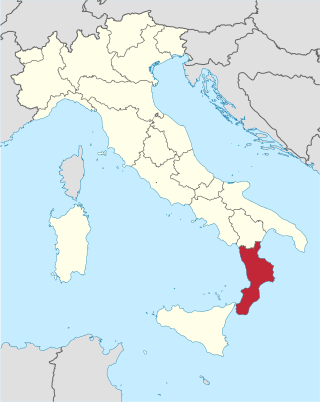
Calabria is a region in Southern Italy. It is a peninsula bordered by Basilicata to the north, the Ionian Sea to the east, the Strait of Messina to the southwest, which separates it from Sicily, and the Tyrrhenian Sea to the west. It has almost 2 million residents across a total area of 15,222 km2 (5,877 sq mi). Catanzaro is the region's capital.

Reggio di Calabria, commonly and officially referred to as Reggio Calabria, or simply Reggio by its inhabitants, is the largest city in Calabria as well as the seat of the Regional Council of Calabria. It has an estimated population between 150,000 and 200,000 and is the twenty-first most populous city in Italy, after Modena and other Italian cities, and the 100th most populated city in Europe. Reggio Calabria is located near the center of the Mediterranean and is known for its climate, ethnic and cultural diversity. It is the third economic centre of mainland Southern Italy. About 560,000 people live in the metropolitan area, recognised in 2015 by Italy as a metropolitan city.

Magna Graecia was the name given by the Romans to the Greek-speaking coastal areas of Southern Italy in the present-day Italian regions of Calabria, Apulia, Basilicata, Campania and Sicily; these regions were extensively populated by Greek settlers starting from the 8th century BC.
Locri is a town and comune (municipality) in the province of Reggio Calabria, Calabria, southern Italy. Its name derives from that of the ancient Greek region of Locris. Today it is an important administrative and cultural centre on the Ionian Coast and within its province.
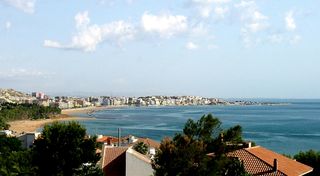
Crotone is a city and comune in Calabria, Italy.
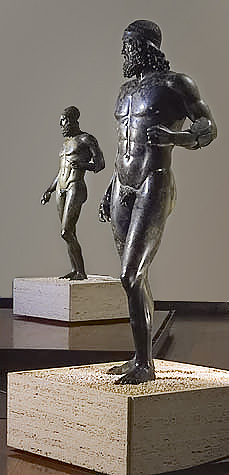
The Riace bronzes, also called the Riace Warriors, are two full-size Greek bronze statues of naked bearded warriors, cast about 460–450 BC that were found in the sea in 1972 near Riace, Calabria, in southern Italy. The bronzes are now in the Museo Nazionale della Magna Grecia in the nearby city of Reggio Calabria. They are two of the few surviving full-size ancient Greek bronzes, and as such demonstrate the technical craftsmanship and artistic features that were achieved at this time.

The sculpture of ancient Greece is the main surviving type of fine ancient Greek art as, with the exception of painted ancient Greek pottery, almost no ancient Greek painting survives. Modern scholarship identifies three major stages in monumental sculpture in bronze and stone: the Archaic, Classical (480–323) and Hellenistic. At all periods there were great numbers of Greek terracotta figurines and small sculptures in metal and other materials.
The Antikythera wreck is a Roman-era shipwreck dating from the second quarter of the first century BC.

The Antikythera Ephebe, registered as: Bronze statue of a youth in the museum collections, is a bronze statue of a young man of languorous grace that was found in 1900 by sponge-divers in the area of the ancient Antikythera shipwreck off the island of Antikythera, Greece. It was the first of the series of Greek bronze sculptures that the Aegean and Mediterranean yielded up in the twentieth century which have fundamentally altered the modern view of ancient Greek sculpture. The wreck site, which is dated about 70–60 BC, also yielded the Antikythera mechanism, a characterful head of a Stoic philosopher, and a hoard of coins. The coins included a disproportionate quantity of Pergamene cistophoric tetradrachms and Ephesian coins, leading scholars to surmise that it had begun its journey on the Ionian coast, perhaps at Ephesus; none of its recovered cargo has been identified as from mainland Greece.

Riace is a comune (municipality) in the Metropolitan City of Reggio Calabria in the Italian region Calabria, located about 50 kilometres (31 mi) south of Catanzaro and about 80 kilometres (50 mi) northeast of Reggio Calabria. Riace borders the municipalities of Camini and Stignano.
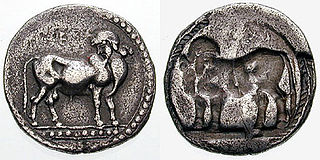
Laüs or Laus was an ancient city on the coast of the Tyrrhenian Sea. It was at the mouth of the Lao River, which formed the boundary between Lucania and Bruttium in ancient times and gave it its name.

The Artemision Bronze is an ancient Greek sculpture that was recovered from the sea off Cape Artemision, in northern Euboea, Greece. According to most scholars, the bronze represents Zeus, the thunder-god and king of gods, though it has also been suggested it might represent Poseidon. The statue is slightly over lifesize at 2.09 meters, and would have held either a thunderbolt, if Zeus, or a trident if Poseidon. The empty eye-sockets were originally inset, probably with bone, as well as the eyebrows, the lips, and the nipples. The sculptor is unknown. The statue is a highlight of the collections in the National Archaeological Museum of Athens.

The National Archaeological Museum of Florence is an archaeological museum in Florence, Italy. It is located at 1 piazza Santissima Annunziata, in the Palazzo della Crocetta.
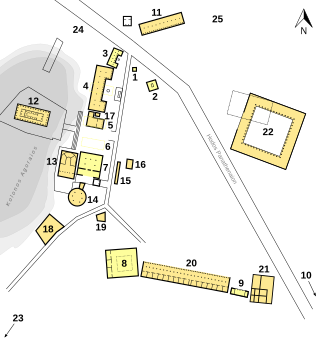
The Temple of Apollo Patroos is a small ruined temple on the west side of the Ancient Agora of Athens. The original temple was an apsidal structure, built in the mid-sixth century BC and destroyed in 480/79 BC. The area probably remained sacred to Apollo. A new hexastyle ionic temple was built ca. 306-300 BC, which has an unusual L-shaped floor plan. Some fragments from the sculptural decoration of this structure survive. The colossal cult statue, by Euphranor, has also been recovered.

The Museo Nazionale della Magna Grecia, Museo Archeologico Nazionale di Reggio Calabria or Palazzo Piacentini is a museum in Reggio Calabria, southern Italy, housing an archaeological collection from sites in Magna Graecia.
Krimisa, Crimisa or Crimissa was an ancient town, probably originating in the 7th century BC, situated in modern Calabria in the region of Punta Alice. It was inhabited by an indigenous people assimilated by the Greeks.

Terina was an ancient city located on the Piano di Tirena hill in Sant'Eufemia Vetere about 20 km (12 mi) from Lamezia Terme in Calabria. The site of the city was allegedly found in 1922 by the archaeologist Paolo Orsi near the modern village of Sant'Eufemia Vetere. A systematic archaeological investigation was made from 1997 and coins, inscriptions and other artefacts retrieved from the site can be seen in the Museo Archeologico Lametino in Lamezia Terme.

The Giants of Mont'e Prama are ancient stone sculptures created by the Nuragic civilization of Sardinia, Italy. Fragmented into numerous pieces, they were discovered in March 1974 on farmland near Mont'e Prama, in the comune of Cabras, province of Oristano, in central-western Sardinia. The statues are carved in local sandstone and their height varies between 2 and 2.5 meters.

The Dancers of Delphi, also known as the Acanthus Column, are three figures in high relief on top of an acanthus column found near the sanctuary of Pythian Apollo at Delphi. They are on display in the Delphi Archaeological Museum and were the inspiration for the first of Claude Debussy's Préludes.

















